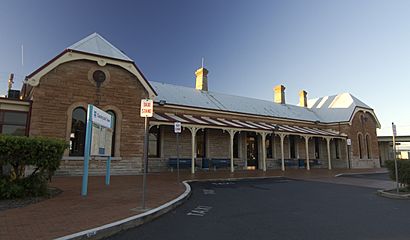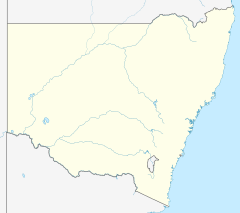Dubbo railway station facts for kids
Quick facts for kids
Dubbo
|
|||||||||||
|---|---|---|---|---|---|---|---|---|---|---|---|
 |
|||||||||||
| Location | Talbragar Street, Dubbo, Dubbo Regional Council, New South Wales Australia |
||||||||||
| Coordinates | 32°14′41″S 148°36′34″E / 32.2448°S 148.6095°E | ||||||||||
| Owned by | Transport Asset Holding Entity | ||||||||||
| Operated by | NSW TrainLink | ||||||||||
| Line(s) |
|
||||||||||
| Distance | 462.20 km (287.20 mi) from Central | ||||||||||
| Platforms | 1 | ||||||||||
| Tracks | 2 | ||||||||||
| Construction | |||||||||||
| Structure type | Ground | ||||||||||
| Disabled access | Yes | ||||||||||
| Other information | |||||||||||
| Station code | DBO | ||||||||||
| History | |||||||||||
| Opened | 1 February 1881 | ||||||||||
| Services | |||||||||||
|
|||||||||||
| Official name | Dubbo Railway Station and yard group | ||||||||||
| Type | State heritage (complex / group) | ||||||||||
| Designated | 2 April 1999 | ||||||||||
| Reference no. | 1130 | ||||||||||
| Type | Railway Platform/ Station | ||||||||||
| Category | Transport - Rail | ||||||||||
| Architect | John Whitton (attributed) | ||||||||||
| Location | |||||||||||
Dubbo railway station is a very old and important train station in Dubbo, New South Wales, Australia. It's also a place where you can catch buses. This station is on the Main Western railway line. It first opened its doors on 1 February 1881.
The station is considered a special historical site. It's officially known as the Dubbo Railway Station and yard group. This important place was added to the New South Wales State Heritage Register in 1999. The station and its surrounding areas were designed by the team of John Whitton, a famous railway engineer.
Dubbo was once a very busy railway hub. It was where several train lines met. These included the Main Western, Molong-Dubbo, and Coonamble lines. The station also had a large place to keep and fix locomotives (train engines).
Bigger train engines, like the 36, 38, and 60 class locomotives, could only travel as far as Dubbo. Smaller engines would then take over for journeys further west. The station used to have an extra platform, but it was removed in 1988. Today, trains from Central Sydney end their journey at Dubbo. You can also catch coaches (buses) from here to places further north-west.
Contents
What Services Run Here?
Dubbo station has seen many changes in its services over the years.
Past Train Services
- The Western Mail train used to run from Central Sydney to Dubbo. These services stopped in November 1988.
- At Dubbo, the Western Mail connected with the Far West Express. This train went to towns like Bourke, Cobar, and Coonamble.
- In 1975, special coaches (buses) were introduced. They replaced all train services that went north and west from Dubbo.
Current Services at Dubbo
- Today, Dubbo is served by NSW TrainLink's daily Central West XPT train. This train travels to and from Central Sydney.
- NSW TrainLink also runs road coach services from Dubbo. You can catch a coach to places like Lithgow, Cootamundra, Broken Hill, Bourke, Nyngan, and Lightning Ridge.
| Platform | Line | Stopping pattern | Notes |
| 1 |
Western Region
|
services to Sydney Central |
|---|
Station History
Most of the stone buildings at Dubbo Railway Station were built between 1879 and 1881. This was in preparation for its opening in 1881. The station master's house was also finished that same year.
Early Additions and Changes
In the late 1800s and early 1900s, more parts were added to the station area:
- 1891: A lamp room and a wool stage were built.
- 1893: The Dubbo West rail siding was added.
- 1897: A carriage shed was built.
- 1898: The western end of the platform was extended.
- 1903: The Dubbo-Coonamble rail line officially opened.
- 1904: A large 20-tonne (22-short-ton) weighbridge was installed. The Sydney end of the platform was also extended.
- 1908: A grain shed was added.
Many more changes happened in the early 1900s. These changes became less frequent by the 1930s and 1940s.
Later Changes and Decommissioning
- By 1975, passenger trains to Bourke, Cobar, and Coonamble were replaced. Instead, road coaches connected with trains at Dubbo station.
- In the 1980s, some older parts of the station were removed. These included a gas siding and a livestock loading area.
- In 1988, the train line between Dubbo and Molong was closed down.
Dubbo Railway Station is still an active station today. It is operated by RailCorp. However, the old station master's house is now privately owned.
Station Design and Features
Dubbo station has some unique and historic features.
Station Buildings
- The main station building was built in 1881. It is made of stone and is a "first class" station building.
- It has platform awnings that stick out, supported by steel posts.
- The station also had a railway refreshment room, also built from stone in 1881.
- There are two old residences nearby. The station master's house on Talbragar Street was built in 1881 from stone. Another stone building at 106 Darling Street was originally a locomotive shed.
Other Structures
- The train platform faces were built in 1881 using stone.
- There is a small pump house near the bridge. It was built around 1881 from corrugated iron.
Why Dubbo Station is Special
Dubbo station and its buildings are very important. They are some of the few railway buildings in New South Wales made of stone. It is also one of the rare "first class" stone railway stations ever built.
The old stone platform faces are very unique and hold great historical value. The station is also next to other old industrial buildings related to the railway. It is a key part of Dubbo's town look, especially since Dubbo is a historic town that attracts tourists. The entire station area is very important to the history of Dubbo and the railway system.
Dubbo railway station was added to the New South Wales State Heritage Register on 2 April 1999. This means it is officially recognized as a place of historical importance.
Rare Historical Significance
Dubbo station is considered rare because of its history. It is also rare in terms of its scientific, archaeological, and social importance.



